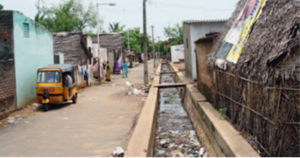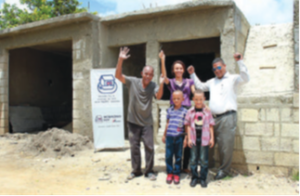Affordability through the improvement of the existing housing stock

ㅤ
Chile: a new approach to defining housing deficits
Some of the most comprehensive and recent information about the housing deficits of a Latin American country can be found in Chile, where the Ministry of Housing and Urbanism (MINVU) carried out an extensive analysis based on data from the nation’s 2002 census. The result of the housing deficit study is a document that provides detailed data about the state of housing and introduces new perspectives on how to assess and understand a housing deficit.
The study used a methodology proposed by CELADE in 1996, segmenting the housing stock into three categories of acceptable, repairable and unacceptable. This assessment was based on a matrix that took into consideration subcategories of housing type, an index of the type and conditions of the roof, walls, and floor, and the type of sanitary facilities found in the dwelling. Dwellings that were deemed acceptable in all three subcategories were obviously graded as acceptable. According to the matrix, dwellings that exhibited a reparable deficiency in type of materials – degraded adobe walls, a fibreglass tile floor or a fibreglass sheet roof, for instance – were deemed repairable, even if the sanitary facilities were considered deficient. Cases that exhibited an unacceptable housing condition – roof or walls made of discarded materials, for instance, or a dirt floor – were deemed irreparable. Even in the case of working sanitary facilities, dwellings types defined as unacceptable – categories of provisional housing typologies – were likewise categorized as unacceptable.
One of the novel aspects of this methodology is its recognition that a qualitative deficiency in a house does not mean that the dwelling, a priori, represents a permanent defficiency in the housing stock of the country. Houses exhibiting certain qualitative deficiencies are defined, within certain parameters, to be recoverable, or repairable. Other houses exhibiting more severe deficiencies (or combinations of deficiencies) are categorized as in need of replacement. Put differently, it recognizes the potential to rehabilitate such dwellings, not just the necessity to replace them. This methodology serves to answer the criticism that housing deficit pronouncements are used as uncontemplated justifications for new construction.
Dutch urban regeneration: an emphasis on deprived neighbourhoods
The national Big Cities Policy assists 18 cities in the Netherlands to respond to problems of high unemployment, crime, polarisation and growing spatial concentrations of low-income households and ethnic minority groups, as well as the physical problems often found in social housing.
The Big Cities Policy rests on three pillars: (i) the economy and employment, (ii) the physical infrastructure, and (iii) the social infrastructure. Funding is used in an integrated manner to improve the quality of urban space, to create more jobs and to eliminate social exclusion in neighbourhoods. This area-based approach focuses on deprived neighbourhoods and contributes to social cohesion through measures implemented by residents, government bodies (local authority, police, social welfare organisations), housing associations and local employers. A recent policy shift has targeted 40 neighbourhoods in the four largest cities for the implementation of area-based regeneration measures.
In Amsterdam, where more than half of the housing is social housing, non-profit housing associations own 205,000 social rental dwellings. While these are distributed across the city in every district, a fair share is concentrated in post-war neighbourhoods such as the Western Garden Cities and the Southeast of Amsterdam. Over time these areas have become less desirable places to live with social exclusion and poverty manifested in a number of ways, although the housing is in a relatively good condition. The new wave of government investment leverages contributions from the housing associations and aims at creating a social mix of rental and owner-occupied housing. Less popular high-rise apartments in the target neighbourhoods are demolished and replaced by medium density dwellings often in mixed ownership neighbourhood blocks. Housing allowances continue to support low-income households and displacement is managed through reallocation programs of the housing associations active in the neighbourhood.
Jawaharlal Nehru National Urban Renewal Mission (JNNURM)

- Figure a: Infrastructure improvement as part of a wider slum upgrading programme in India Photo © Maartje van Eerd. Source: https://mirror.unhabitat.org/pmss/getElectronicVersion.asp?nr=3225&alt=1
India’s national flagship programme is the Jawaharlal Nehru National Urban Renewal Mission (JNNURM), a six-year programme that commenced in 2006. It responds to the need for investment and policy reform at both national and city level to address physical aspects of urban areas, in particular housing, built heritage, infrastructure and services. It pays particular attention to the needs of Economically Weaker Sections (EWS) and Lower Income
Group (LIG). The stated aims are to ‘augment social and economic infrastructure in cities’, ensure basic services to the urban poor including security of tenure at affordable prices, initiate wide-ranging sector reforms and strengthen municipal governments to decentralise. The two components that address affordable land and housing provision are Basic Services to the Urban Poor (BSUP) and Integrated Housing and Slum Development Programme (IHSDP).
BSUP focuses on the integrated upgrading of slums in 65 major cities. It includes the provision of basic urban services, urban improvement and rehabilitation projects, community services projects (such as water supply, toilets, baths, etc), affordable housing projects, and street lighting.
Programa Vivienda en Lote Familiar
In the late 1990’s a coalition of NGO’s submitted a plan for addressing low-income housing needs to a newly sympathetic municipal administration of Mexico City, Mexico, that resulted in the pilot program of the Mejoramiento en Lote Familiar program (Improvement on Family Lot Program). The program provides subsidized loans for low-income households to improve or expand their existing homes or build a new home on an existing plot owned by the borrowers’ family.
The maximum loan for improvements was USD 3,486 and USD 6,845 for new construction. Loan terms ranged from three to eight years depending on the amount lent. Technical assistance was provided by a large network of building professionals tending to the thousands of families enrolled in the improvement program, the cost of which was rolled into the loan. Fifty-seven per cent of the loans were made to households living in marginal areas, one of the populations targeted by the program.
Between 2001 and 2005, following this prioritization of improvements, nearly 100,000 housing improvements were carried out. The success of the program is likely due to the large infusion of resources invested in the program by the municipal government, the highly favourable loan terms offered to low-income households, and the pent-up demand on the part of low-income households for an accessible and well-promoted finance tool to improve their living conditions. The volume of improvement actions taken also translates into a significant ripple effect in the local construction market, with an estimate of 55,000 jobs indirectly and directly created.
All told, the program’s success in reaching households in marginal areas (76% of actions) suggests that it satisfied objectives of improving precarious housing, addressing qualitative and quantitative deficiencies, and strengthening rooted families in such neighbourhoods. It is worth noting the role that the coalition of housing NGOs played in the initial stage of the program, putting housing improvements for low-income households on the agenda of a newly receptive municipal government and ushering the program through its initial growth phase.
Patrimonio Hoy, Mexico – Corporate Responsibility for Materials Affordability

- Figure b: PH beneficiaries. Photo: Patrimonio Hoy. Source: Patrimonio Hoy – CEMEX. Available online. Extracted from: https://publications.iadb.org/publications/spanish/document/Vivienda_Qu%C3%A9_viene_de_pensar_la_unidad_a_construir_la_ciudad.pdf
Mexico faces a growing housing deficit, with 34% of families living in homes with a qualitative deficit. As in many other developing countries, low-income families in Mexico adopt a different method of saving than the traditional ones of middle and upper-income families, since they do not receive regular paychecks or subsidies and grants from the Government, nor do they have access to banks or credit. For this reason, historically, the progressive self-construction of housing covered between 30% and 40% of the cement market in the country. High market fragmentation, limited purchasing power, and lack of formal financing make developing homes using this method complicated and comparatively expensive. Patrimonio Hoy (PH) was originally launched in Mexico and has since expanded to other Latin American markets. PH was designed to overcome all the barriers low-income families face in improving their home. By offering personalized financing solutions to their customers, they are not only changing the landscape of financial products in the countries in which they operate, but also changing the saving and spending habits of some of these previously underserved demographics. Thus, they benefit the local economy.
More information:
- UN-Habitat’s Affordable Land and Housing in Latin America and the Caribbean Report. Source: MINVU, 2004; https://unhabitat.org/sites/default/files/download-manager-files/Affordable%20land%20and%20housing%20in%20Latin%20America%20and%20the%20Caribbean.pdf
- UN-Habitat’s Affordable Land and Housing in Europe and North America Report. Source: van Kempen, 2000; https://unhabitat.org/sites/default/files/download-manager-files/Affordable%20Land%20and%20Housing%20in%20Europe%20and%20North%20America.pdf
- UN-Habitat’s Affordable Land and Housing in Asia Report. Source: https://mirror.unhabitat.org/pmss/getElectronicVersion.asp?nr=3225&alt=1
- UN-Habitat’s Affordable Land and Housing in Latin America and the Caribbean Report. Source: Saborido, 2006, Ortiz and Zárate, 2006; https://unhabitat.org/sites/default/files/download-manager-files/Affordable%20land%20and%20housing%20in%20Latin%20America%20and%20the%20Caribbean.pdf
- BID’s Report Vivienda ¿Qué viene?: de pensar la unidad a construir la ciudad. Source: https://publications.iadb.org/publications/spanish/document/Vivienda_Qu%C3%A9_viene_de_pensar_la_unidad_a_construir_la_ciudad.pdf